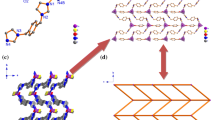Abstract
Two bimetallic metal–organic frameworks (MOFs), specifically {2[LiM(TDA)2(DMF)]·NH2+(CH3)2}n (M = Co (HNU-29) or Zn (HNU-30), TDA = 2,5-thiophenedicarboxylate), were synthesized by solvothermal methods. X-ray crystal structures of the two MOFs showed them to be isostructural. Thus, in both cases, the metal secondary building units were connected by TDA2− ligands to form a 3D framework whose structure can be simplified to the twofold interpenetrated dia net. HNU-29 showed excellent photocatalytic activity for the degradation of methylene blue (MB) under visible light even without the addition of H2O2 as an electron acceptor, remaining stable even after several cycles of reuse. The MB degradation followed first-order kinetics, and the photocatalytic degradation mechanism was found to be related to the effective ligand-to-metal charge transfer within the framework.






Similar content being viewed by others
References
Luo X, Zhan Y, Huang Y (2011) Removal of water-soluble acid dyes from water environment using a novel magnetic molecularly imprinted polymer. J Hazard Mater 187:274–282
Rafatullah M, Sulaiman O, Hashim R (2010) Adsorption of methylene blue on low-cost adsorbents: a review. J Hazard Mater 177:7080
Shi X, Tian A, You J (2018) Degradation of organic dyes by a new heterogeneous Fenton reagent—Fe2GeS4, nanoparticle. J Hazard Mater 353:182–189
Ahmad N, Younus HA, Chughtai AH, Hecke KV (2018) Synthesis of 2D MOF having potential for efficient dyes adsorption and catalytic applications. Catal Sci Technol 16:4010–4017
Danni J, Piao X, Han W, Guangming Z, Danlian H, Ming C, Cui L, Chen Z, Jia W, Wenjing X (2018) Strategies to improve metal organic frameworks photocatalyst’s performance for degradation of organic pollutants. Coord Chem Rev 376:449–466
Dastan D, Chaure N, Kartha M (2017) Surfactants assisted solvothermal derived titania nanoparticles: synthesis and simulation. J Mater Sci Mater Electron 28:784–7796
Dastan D, Panahi SL, Chaure NB (2016) Characterization of titania thin films grown by dip-coating technique. J Mater Sci Mater Electron 27:12291–12296
Ren B, Shen W, Li L (2018) 3D CoFe2O4, nanorod/flower-like MoS2, nanosheet heterojunctions as recyclable visible light-driven photocatalysts for the degradation of organic dyes. Appl Surf Sci 447:711–723
Chang CJ, Lin YG, Weng HT (2018) Photocatalytic hydrogen production from glycerol solution at room temperature by ZnO–ZnS/graphene photocatalysts. Appl Surf Sci 451:198–206
Cui GH, He CH, Jiao CH (2012) Two metal–organic frameworks with unique high-connected binodal network topologies: synthesis, structures, and catalytic properties. CrystEngComm 14:4210–4216
Yang H, He XW, Wang F (2012) Doping copper into ZIF-67 for enhancing gas uptake capacity and visible-light-driven photocatalytic degradation of organic dye. J Mater Chem 22:21849–21851
Babaei H, Mcgaughey AJH, Wilmer CE (2018) Transient mass and thermal transport during methane adsorption into the metal-organic framework HKUST-1. ACS Appl Mater Interfaces 10:2400–2406
Li M, Yang W, Qiu P, Ren G, Li C, Chen Z, Wang Y, Pan Q (2018) Two efficient pH sensors based on heteronuclear metal-organic frameworks. J Lumin. https://doi.org/10.1016/j.jlumin.2018.09.056
Gonen S, Lori O, Cohentaguri G (2018) Metal organic frameworks as a catalyst for oxygen reduction: an unexpected outcome of a highly active Mn-MOF-based catalyst incorporated in activated carbon. Nanoscale 10:9634–9641
Li Q, Fan ZL, Xue DX (2018) Multi-dyes@MOF composite boosts highly efficient photodegradation of ultra-stubborn dye of reactive blue 21 under visible-light irradiation. J Mater Chem A 6:2148–2156
Vidyasagar D, Aditi K, Sachin GG, Suresh SU (2018) Open-mouth spherical g-C3N4/Fe-2,5-thiophenedicarboxylic acid hybrid photocatalyst for dye degradation and bacterial inactivation. J Chem Technol Biotechnol 2:1. https://doi.org/10.1002/jctb.5821
Jing HP, Wang CC, Zhang YW (2014) Photocatalytic degradation of methylene blue in ZIF-8. RSC Adv 4:54454–54462
Zhang M, Wang L, Zeng T (2018) Two pure MOF-photocatalysts readily prepared for the degradation of methylene blue dye under visible light. Dalton Trans 47:4251–4258
Dastan D, Banpurkar A (2016) A Solution processable sol–gel derived titania gate dielectric for organic field effect transistors. J Mater Sci Mater Electron 28:3851–3859
Dolomanov OV, Bourhis LJ, Gildea RJ, Howard JAK, Puschmann H (2009) J Appl Cryst 42:339–341
Sheldrick GM (2015) SHELXT—integrated space-group and crystal-structure determination. Acta Cryst C 71:3–8
Spek AL (2003) Single-crystal structure validation with the program PLATON. J Appl Cryst 36:3–17
Panahi SL, Dastan D, Chaure NB (2016) Characterization of zirconia nanoparticles grown by sol–gel method. Adv Sci Lett 22:941–944
Dastan D (2017) Effect of preparation methods on the properties of titania nanoparticles: solvothermal versus sol–gel. Appl Phys A 123:699
Wen T, Zhang DX, Liu J, Lin R, Zhang J (2013) A multifunctional helical Cu(I) coordination polymer with mechanochromic, sensing and photocatalytic properties. Chem Commun 49:5660–5662
Wu P, Liu Y, Li Y (2016) Cadmium(II)-based metal-organic framework for selective trace detection of nitroaniline isomers and photocatalytic degradation of methylene blue in neutral aqueous solution. J Mater Chem A 4:16349–16355
He J, Zhang Y, Zhang X (2018) Highly efficient Fenton and enzyme-mimetic activities of NH2-MIL-88B(Fe) metal organic framework for methylene blue degradation. Sci Rep 8:5159
Xu WT, Ma L, Ke F (2014) Metal-organic frameworks MIL-88A hexagonal microrods as a new photocatalyst for efficient decolorization of methylene blue dye. Dalton Trans 43:3792–3798
Liu B, Yu ZT, Yang J, Hua W, Liu YY, Ma JF (2011) First three-dimensional inorganic-organic hybrid material constructed from an “inverted Keggin” polyoxometalate and a copper(I)-organic complex. Inorg Chem 50:8967–8972
Du JJ, Yuan YP, Sun JX (2011) New photocatalysts based on MIL-53 metal-organic frameworks for the decolorization of methylene blue dye. J Hazard Mater 190:945–951
Silva CG, Corma A, García H (2010) Metal–organic frameworks as semiconductors. J Mater Chem 20:3141–3156
Dastan D, Londhe PU, Chaure NB (2014) Characterization of TiO2 nanoparticles prepared using different surfactants by sol–gel method. J Mater Sci Mater Electron 25:3473–3479
Acknowledgements
This work was supported by the National Natural Science Foundation of China (21761010), the Natural Science Foundation of Hainan Province (217018 and 217055), Hainan University start-up fund (kyqd1654 and KYQD(ZR)1806) and the Opening Project of Key Laboratory of Polyoxometalate Science of Ministry of Education (RERU2018009). Hainan Provincial Graduate Innovation Research Project (Hys2018-55).
Author information
Authors and Affiliations
Corresponding authors
Electronic supplementary material
Below is the link to the electronic supplementary material.
Rights and permissions
About this article
Cite this article
Feng, L., Ren, G., Wang, F. et al. Two bimetallic metal–organic frameworks capable of direct photocatalytic degradation of dyes under visible light. Transit Met Chem 44, 275–281 (2019). https://doi.org/10.1007/s11243-018-0292-7
Received:
Accepted:
Published:
Issue Date:
DOI: https://doi.org/10.1007/s11243-018-0292-7




